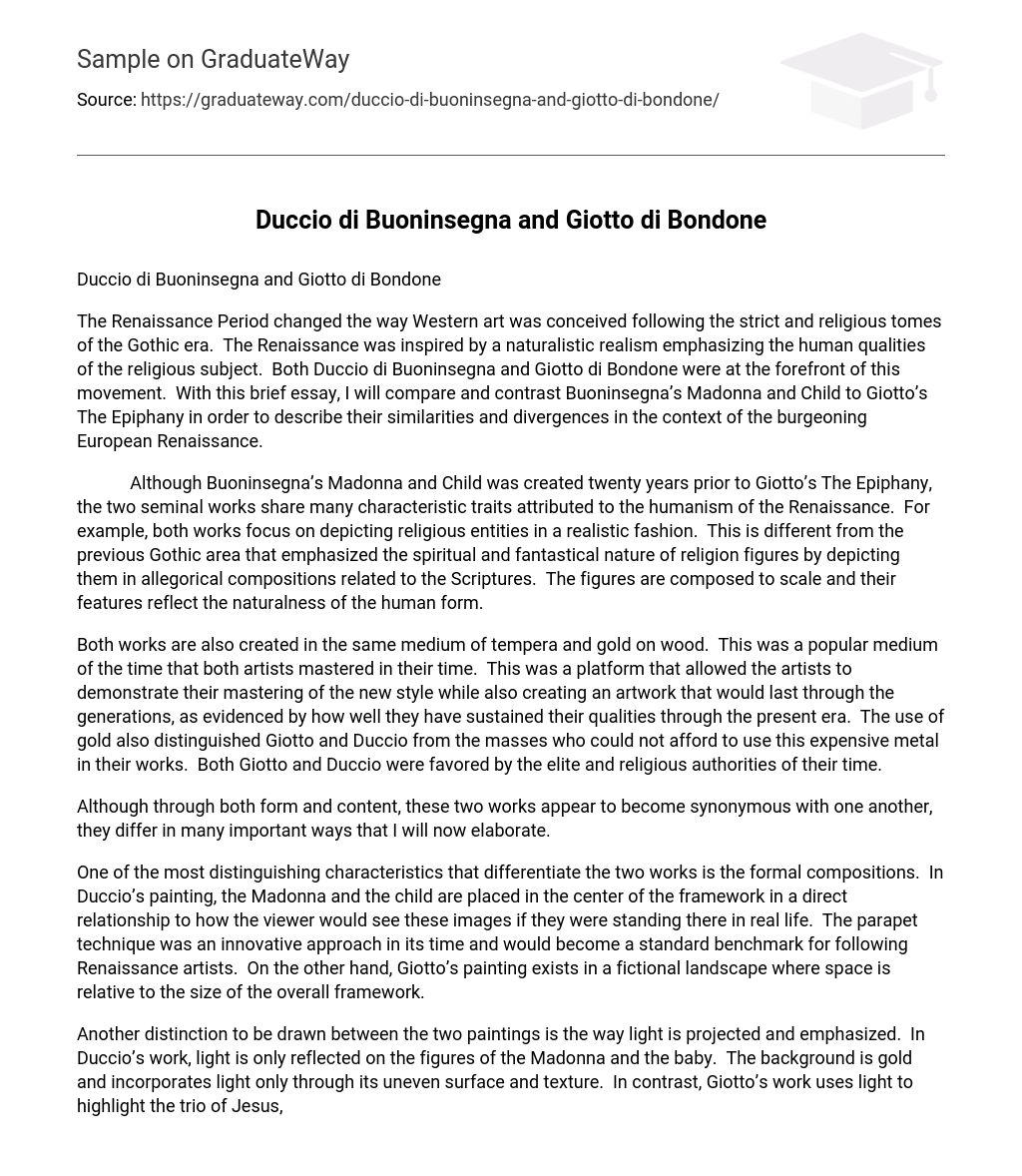The Renaissance Period revolutionized Western art by breaking away from the strict and religious themes of the Gothic era. It was characterized by a naturalistic realism that highlighted the human qualities of religious subjects. Duccio di Buoninsegna and Giotto di Bondone were both pioneers of this movement. In this essay, I will compare and contrast Buoninsegna’s Madonna and Child with Giotto’s The Epiphany to illustrate their similarities and differences in the context of the burgeoning European Renaissance.
Although Buoninsegna’s Madonna and Child was created twenty years prior to Giotto’s The Epiphany, the two seminal works share many characteristic traits attributed to the humanism of the Renaissance. For example, both works focus on depicting religious entities in a realistic fashion. This is different from the previous Gothic era that emphasized the spiritual and fantastical nature of religious figures by depicting them in allegorical compositions related to the Scriptures. The figures are composed to scale, and their features reflect the naturalness of the human form.
Both works were created using the same medium of tempera and gold on wood. This was a popular medium during their time, which both artists mastered. It allowed them to demonstrate their mastery of the new style while creating artwork that would last through generations, as evidenced by how well they have sustained their qualities to this day. The use of gold also distinguished Giotto and Duccio from those who could not afford this expensive metal in their works. Both artists were favored by the elite and religious authorities of their time.
Although these two works may seem synonymous in both form and content, they actually differ in many significant ways that I will now explain.
One of the most distinguishing characteristics that differentiate the two works is their formal compositions. In Duccio’s painting, the Madonna and child are placed in the center of the framework, creating a direct relationship with how viewers would see them if they were standing there in real life. The parapet technique was an innovative approach for its time and became a standard benchmark for Renaissance artists who followed. In contrast, Giotto’s painting exists within a fictional landscape where space is relative to the size of the overall framework.
Another distinction between the two paintings is how they project and emphasize light. In Duccio’s work, light only reflects on the figures of the Madonna and the baby. The background is gold and incorporates light only through its uneven surface and texture. On the other hand, Giotto’s work uses light to highlight Jesus, Joseph, and Mary as a trio. These three figures have a halo of light revolving around their heads to separate them from other figures in the painting. Giotto’s background also has an arc of shading that gives an impression of a night sky behind foreground elements. Duccio’s background gives an impression that Madonna and baby are in an indoor setting due to its flatter background and even shading.
Although both of these works focus on the religious nature of their belief systems, they emphasize different aspects. In Madonna and Child, the interaction between the mother and child highlights their psychological and biological relationship. The child’s eyes are directed upward towards hers, while she has a contemplative facial expression with a slight smile. Additionally, the child is pulling away the mother’s robe from her eyes in an attempt to make eye contact with his creator. Duccio also hints at the mythological existence of his subjects through a faint outline of a halo surrounding the Madonna that is integrated into the background.
Giotto’s depiction emphasizes the mythological birth of Jesus as described in Scripture. He combines elements of both fiction and fact in Christianity. By portraying these forms with a humanistic and natural form, while also including halos and angels with wings flying in the background, he creates a bridge for understanding the mythological within the context of present trends towards artistic realism.
Overall, these two works provide a framework for understanding the artistic impulses that were at the center of the burgeoning European Renaissance. Giotto di Bondone and Duccio di Buoninsegna utilized different points of emphasis on form and function to shift their focus towards naturalism, which was absent during the Gothic era. Although they both continued to focus on religious and spiritual subjects, they aimed to provide a bridge for understanding their present situation in the context of history.





